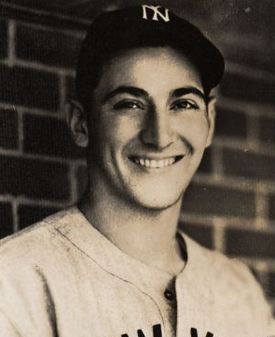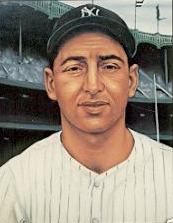

|
|
Marius Russo
Date and Place of Birth: July 19, 1914 Brooklyn, New York
Died: March 26, 2005 Fort Myers, Florida
Baseball
Experience:
Major League
Position:
Pitcher
Rank:
Corporal
Military Unit:
US Army
Area Served: Pacific Theater of Operations
 Marius
U Russo was born on July 19, 1914 in
Marius
U Russo was born on July 19, 1914 in
In his rookie season with
In 1940, he was 14-8 with the Yankees and was
14-10 in 1941 as well as being an American League all-star
selection. In Game 3 of the 1941 World Series, Russo and the Dodgers
right-hander Freddie Fitzsimmons were in a scoreless duel through
six innings at Ebbets Field. With two outs in the seventh and Joe
Gordon on second, Russo, who batted .231 that season, smashed a
liner that caromed high off Fitzsimmons's left knee. The ball was
caught by shortstop Pee Wee Reese, retiring Russo, but Fitzsimmons
incurred a broken knee.
Hugh Casey, replacing
Fitzsimmons, gave up four straight singles in the eighth as the
Yankees scored twice and went on to a 2-1 victory behind Russo's
four-hit complete game.
Suffering from a sore
shoulder, Russo made just nine appearances for the Yankees in 1942
for a 4-1 record and 2.78 ERA. He pitched in 24 games in 1943, but
was 5-10 – the only Yankee pitcher that year to have a losing
record. However, he hurled a seven-hit shutout in the fourth game of
the World Series against the Cardinals.
After
1943 season, Russo worked as an expediter in the Republic Airplane
Works at
 He
reported to
He
reported to
"The guy has lived up to his press notices," declared Corporal Norman K Evans, sports editor of Fort Monmouth's Signal Corps Message on June 23, 1944. "In 24 innings of pitching as a Signalman, Marius Russo has allowed but three singles, two of which were of the tainted variety. Not even the semblance of a run has been garnered off the talented southpaw. But more than just mechanical perfection has made him one of the most popular big leaguers in the service. The games in the Signal Corps Diamond League are as important to Russo as the World Series games last October. He offers his sound baseball knowledge to the young hurlers on the staff. He runs out every grounder when he's at the plate. He is strictly a team player. Off the field, the ex-Yank is modest and shy. Just another slightly homesick recruit."
When he wasn't scheduled to pitch, Russo played the outfield or first base, giving him the opportunity to demonstrate his defensive prowess. "The greatest catch of the year," reported the Signal Corp Message on July 14, 1944, "highlighted Camp Wood's 5-0 shutout of the rampant Station Complement nine.
"Roy Tarr met one of Hank Soven's curves with the meat end of the bat and sent the ball sailing high and far over the center fielder's head. With the crack of the bat, Marius Russo turned and streaked for the tent area. About a mile and a half out, he turned slightly and pulled down the ball with his gloved hand. Few of the lucky spectators have ever seen a more sensational catch."
Russo was no slouch at the plate either. Following his sensational catch, he strode to the plate and sent a mighty drive between the outfielders, crossing home plate standing up.
On June
6, 1944, when all major league games were called off on account of
the D-Day invasion, Russo played first base for the Signal Corps
All-Stars at
Russo
left Fort Monmouth for assignment to
At Camp
Crowder, Russo continued to play all out. On September 17, he combined with
Charley Suche and Tommy Bridges to throw a 6-0 no-hitter against the
Sheffield Steels at
Corporal
Russo was discharged from service on January 15, 1946. He
immediately joined the Yankees and just as quickly was rushed to
hospital for further elbow surgery. He made just eight appearances
for the Yankees that season and was 0-2 with a 4.34 ERA. By 1947,
Russo was back in the minors with
Marius
Russo, who was later an executive with
Grumman Aircraft on Long Island, passed away on March 26, 2005 in
Created April 14, 2008. Updated April 21, 2008.
Copyright © 2008 Gary Bedingfield (Baseball in Wartime). All Rights Reserved.